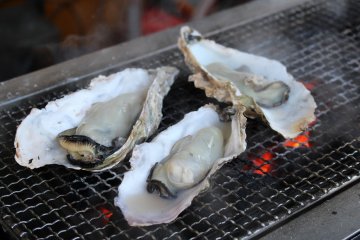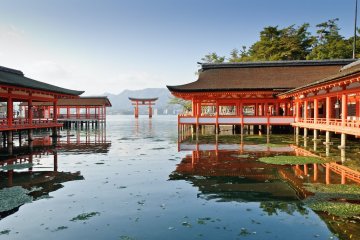
Taman Miyajima Momijidani
Tomoko KamishimaTaman Momijidani dengan pemandangan dedaunan musim gugurnya terletak di lembah kaki gunung Pegunungan Misen, Pulau Miyajima.

Momijidani Park (紅葉谷公園, Momijidani-Kōen) is one of the most famous maple leaves valley parks in Japan. The park is located at the foot of Mt. Misen, along Momijidani River, behind Itsukushima Shrine in Miyajima, Hiroshima. [Wikipedia]
It's about a 20-minute walk south of Miyajima's pier area along a route that cuts through the Omotesando shotengai area.
It's also just a 2-minute walk from the Miyajima Ropeway at the base of Mount Misen.

Taman Momijidani dengan pemandangan dedaunan musim gugurnya terletak di lembah kaki gunung Pegunungan Misen, Pulau Miyajima.


Festival Tiram (kaki 牡蠣) di pulau Miyajima diadakan setiap tahun pada bulan Februari selama musim tiram. Perayaan ini tepat di sebelah pelabuhan feri dan pastinya menjadi pilihan mudah jika Anda penyuka makanan laut.

The Itsukushima Shrine is located on the shores of Miyajima, an island in the Seto Inland Sea not far from Hiroshima city. While the name Itsukushima means “island of worship”, the site is more famously known as “the floating shrine”, as the buildings appear to be floating on the water when the tide rolls in. Itsukushima’s main shrine was first constructed in AD 593, and was mentioned in a famous Japanese book (Nihon Koki, or Notes on Japan) in AD 811. The shrine became popular as a pilgrimage destination for members of the Imperial Court during the Heian Period (745-1185) and remained an important location in the Edo Period for those living in western Japan. The main shrine precinct consists of a collection of buildings, such as the Purification Hall and the stage for bugaku (court music) performances. Many of the buildings are linked by covered corridors and dotted with bronze lanterns from the early 20th century. An arched bridge, dating back to 1557, was said to be used by Imperial messengers and is one of the links between the shrine and the mainland. Most notably, Itsukushima is home to a Noh stage that dates back to the early Edo Period, and is significant for the fact that it’s the only Noh stage in the country that floats upon the sea. Due to their history and unique design, the buildings of Itsukushima Shrine were designated as a National Treasure in 1952 and became a UNESCO World Heritage Site in 1996. Visitors who wish to see the shrine as it “floats upon the waves” would do best to plan their visit according to the tides. A schedule of the day’s high and low tides is usually posted at the shrine’s main entrance.

The Miyajima Omotesando Shopping Street is a 350m-long arcade that acts as one of the main paths between the island's port and Itsukushima Shrine. It's a lively thoroughfare filled with souvenir shops, street-side food counters as well as cafes, bars and restaurants. A folding roof provides a canopy to shelter from both rain or sun. Local delicacies steal the show so expect oysters, conger eel, momiji manju (a baked or deep-fried snack) or Miyajima craft beer along the route. Plenty of souvenir shops sell the famous shamoji (traditional wooden rice paddle) used for serving rice. A giant rice paddle—the symbolic Ōshakushi—used to be located here but has been relocated to the nearby etto Miyajima Community Centre. With most visitors to Miyajima not necessarily staying on the island overnight, many of the shops close by 5pm or 6pm. Nonetheless, once the sun sets the street takes on a warm, charming vibe under the glow of the lantern light that lines the street.

Daishō-in or Daisyō-in is a historic Japanese temple complex with many temples and statues on Mount Misen, the holy mountain on the island of Itsukushima, off the coast of Hatsukaichi, Hiroshima, Japan. It is the 14th temple in the Chūgoku 33 Kannon Pilgrimage and famous for the maple trees and their autumn colors. [Wikipedia]